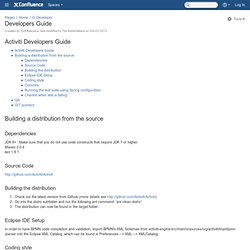

HandySoft: Workflow Software and Business Process Management (BPM) Software by HandySoft. BPMLink - ADELAIDE. Activiti.org. Activiti - Safari tutorial. A couple weeks ago I implemented 2 web applications and a REST API for a new open sourced BPM / BPMN 2.0 engine named Activiti.

Feel free to visit where you may download the distribution (Apache licensed) and play around with it. The actual BPM engine is just a simple jar file having the benefit of therefore being deployable in virtually any JAVA environment. The whole architecture for the REST API and web applications was built using the Spring Surf framework. I will write a series of blog posts introducing the Spring Surf framework by writing an example application for a “Safari” company.
The application will be built using Maven and will contain of 4 modules: safari-root – The root module containing documentation and from which the project is built.safari-core – The core business logic packaged into a .jar file.safari-rest – The Safari JSON REST API packaged as a deployable .war-file.safari-shop – The Safari Web Shop packaged as a deployable .war file. <modules><module>.. <! <! Configuration Instructions for Activiti. Developers Guide - Activiti. Dependencies JDK 6+ : Make sure that you do not use code constructs that require JDK 7 or higher.

Maven 3.0.4 Ant 1.8.1 Source Code Building the distribution Check out the latest version from Github (more details see into the distro subfolder and run the following ant command: 'ant clean distro'The distribution can now be found in the target folder. Eclipse IDE Setup In order to have BPMN code completion and validation, import BPMN's XML Schemas from activiti-engine/src/main/resources/org/activiti/impl/bpmn/parser into the Eclipse XML Catalog, which can be found in Preferences --> XML --> XMLCatalog. Coding style In the eclipse directory of the root activiti source directory are some files that should be imported as eclipse preferences. Commits As much as possible try to group all related changes into single commits. Before committing, run the following check to see if all is OK. Automating a process with Activiti. BPM - Process Developments. Intalio. Drools - JBoss. Drools - The Business Logic integration Platform Drools 5 introduces the Business Logic integration Platform which provides a unified and integrated platform for Rules, Workflow and Event Processing.

It's been designed from the ground up so that each aspect is a first class citizen, with no compromises. Upcoming events JUDCon Brasil Overview Drools and jBPM consist out of several projects: Drools Guvnor (Business Rules Manager) Taverna. Ruote. jBPM - JBoss. jBPM is a flexible Business Process Management (BPM) Suite.

It makes the bridge between business analysts and developers. Traditional BPM engines have a focus that is limited to non-technical people only. jBPM has a dual focus: it offers process management features in a way that both business users and developers like it. What does jBPM do? A business process allows you to model your business goals by describing the steps that need to be executed to achieve that goal and the order, using a flow chart. This greatly improves the visibility and agility of your business logic, results in higher-level and domain-specific representations that can be understood by business users and is easier to monitor. The core of jBPM is a light-weight, extensible workflow engine written in pure Java that allows you to execute business processes using the latest BPMN 2.0 specification. jBPM is also not just an isolated process engine. Process languages jBPM6 What to do if I encounter problems or have questions?
Leading the World in Process Innovation. ProcessMaker. Wiki. TIBCO. The Kepler Project — Kepler. Petri net - Wiki. A Petri net (also known as a place/transition net or P/T net) is one of several mathematical modeling languages for the description of distributed systems.

A Petri net is a directed bipartite graph, in which the nodes represent transitions (i.e. events that may occur, signified by bars) and places (i.e. conditions, signified by circles). The directed arcs describe which places are pre- and/or postconditions for which transitions (signified by arrows). Some sources[1] state that Petri nets were invented in August 1939 by Carl Adam Petri — at the age of 13 — for the purpose of describing chemical processes.
Like industry standards such as UML activity diagrams, BPMN and EPCs, Petri nets offer a graphical notation for stepwise processes that include choice, iteration, and concurrent execution. Unlike these standards, Petri nets have an exact mathematical definition of their execution semantics, with a well-developed mathematical theory for process analysis.